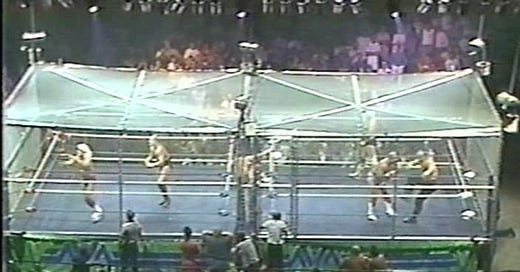In 1987 Dusty Rhodes had a dream. That dream was a match to end all matches. That match… was War Games. With WWE’s Survivor Series War Games match just finishing up, this article felt timely. We talk all things Survivor Series War Games on the latest episode of Card Subject to Change, which you can find on YouTube, Facebook, or wherever you stream your favorite podcasts, so I won’t go into details about this year’s event here. Instead, I’m going to give you an overview of the match itself.
To start, War Games takes place in two rings surrounded by a steel cage. In wrestling, a cage match is a traditional “blow off” to a feud. What I mean by that is this: the cage match will be the end of a rivalry in a lot of cases, or at least that’s how it used to be. The difference between a standard cage match and War Games, however, is the fact that this is faction warfare.
I can say that one ring isn’t big enough to handle two teams of 5 (traditionally), but you could counter me with a number of matches that feature upwards of 20 or more wrestlers. In this instance, they want more room for move violence, so to speak. The concept of War Games is two teams (aka factions) compete inside to settle a score. During Dusty’s days, the main faction to go against was the Four Horsemen, led by WWE Hall of Famer Ric Flair. Dusty would put together a team based on wrestlers that were feuding with various members of the Horsemen and they would enter the cage.
What makes War Games unique, though, is the fact that not everyone is in the cage to begin with. The spectacle starts with one member from each team entering for a timed period, generally 3-5 minutes, and then another member of one team would enter, giving the advantage to a specific faction. The determination of which team would get the advantage is typically determined by a coin flip or a singles match between faction members where the person who wins gains the advantage for their faction. This back and forth of competitors entering the cage continues until all entrants are in the ring.
Once everyone has entered the cage, the actual match begins. This period was once referred to as “The Match Beyond” but WWE has since dropped that moniker, much to my disappointment. In fact, there are a few things WWE has done to “modernize” this match.
In the early iterations of War Games, you could only win by submission or surrender. In today’s era, pinfall or submission is the way to gain victory. Another stipulation added to WWE’s version of The American Dream’s vision is that if any competitor escapes the cage, they lose the match. With the removal of the roof of the cage, WWE also allows for some high spots where wrestlers jump off the top of the cage onto their competitors.
While War Games traditionally featured teams of 4 or 5, depending on the year and the story leading up to the event, there was one year that was the exception. In 1998, WCW went a different direction, since there were three major factions in competition at the time of the event that featured War Games. In ‘98 you had three teams of three: nWo Hollywood (aka black and white, the original nWo), nWo Wolfpac (the red and black), and WCW. This match featured the same caged format, however, they allowed for pinfall as well as submission and the winner of this 9 man war would be the #1 Contender to the WCW World Heavyweight Championship.
One other variation of War Games was in 2000 under the questionable guidance of Vince Russo, a polarizing figure in professional wrestling. In conjunction with the film Ready to Rumble, this iteration of War Games, called “War Games 2000: Russo’s Revenge” did not take place on a monthly PPV event as it normally does, but instead was on weekly free television, airing on an episode of Monday Nitro in early September of that year. This match took place in a three tiered cage, similar to that featured in the aforementioned movie. You can also see the “Doomsday Cage” showcased on the WCW PPV event Slamboree 2000. If you want our thoughts on Slamboree 2000, head into our podcast archives, we tear the entire show to pieces.
On a final note, AEW has their own version of War Games every year, but due to naming rights, theirs is called Blood and Guts. For all intents and purposes, it’s a variant on War Games.
Now that you’ve had a little insight into War Games, hop on Peacock and check out any incarnation of this fun match. You can find the match featured on WCW Fall Brawl for several years, NXT: War Games, and most recently Survivor Series. Well, the ref is giving me the signal to go home (that means wrap things up in the wrestling world). Thanks for reading and happy wrestling!




